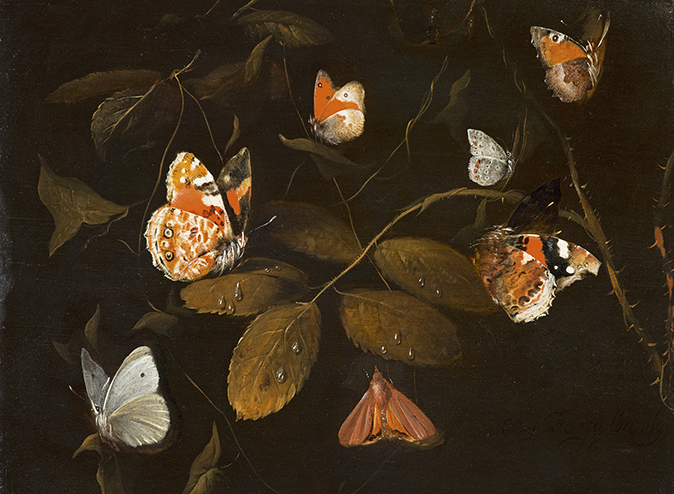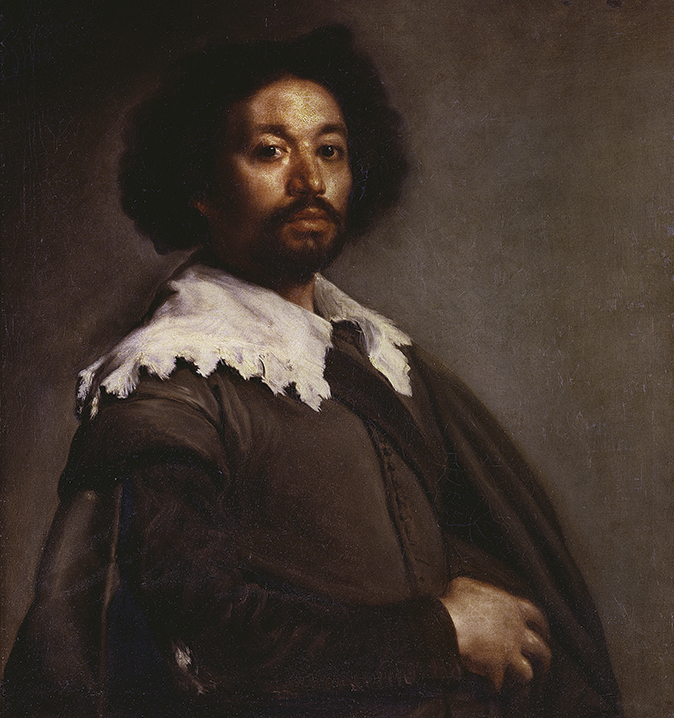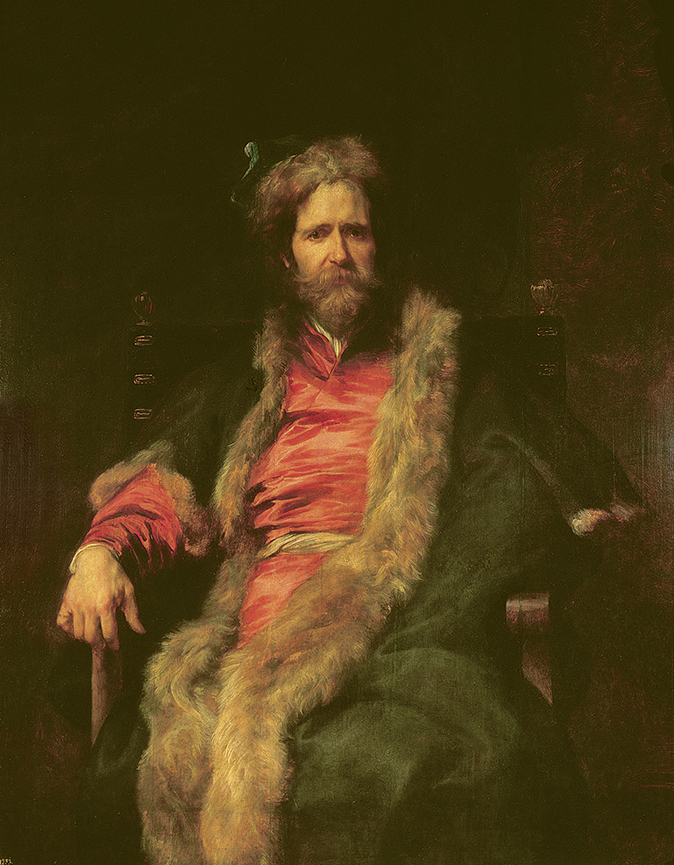My favourite painting: Merryn Somerset Webb
'It still represents for me the small moments of calm in an otherwise completely chaotic time'


Six Butterflies and a Moth on a Rose Branch, about 1690, by William Gouw Ferguson (1632/33– after 1695), 8in by 10in, Scottish National Gallery, Edinburgh
Merryn Somerset Webb says:
When I had small children, we rarely left the ground floor of the National Gallery in Scotland. Instead, we did the same circuit every visit. In the main door. Check out an ancestor of my husband’s on the wall to the right. Find the animals in all the paintings in the “Painting as Spectacle” section. And then on to the little room to the back left, just before heading for Pizza Express. There, I found this precise little painting, which I have popped back to see regularly ever since (the children can barely be dragged to galleries anymore). My daughter loves it, too, and when she was tiny, we spent ages marvelling over the intricacy and brightness of the butterfly wings against the darkness. Years after those happy outings, it still represents for me the small moments of calm in an otherwise completely chaotic time.
Merryn Somerset Webb is Editor in Chief of Moneyweek and a columnist for The Financial Times
John McEwen comments on Six Butterflies and a Moth on a Rose Branch:
Ferguson may have been born in Scotland, but, like many of his countrymen during the Civil War and Commonwealth, he exiled himself to the Continent. His speciality—sporting trophy pictures of hung dead birds—was a Dutch genre. His mastery has subsequently led fraudsters to add false signatures of the best Dutch masters—even the supreme Jan Weenix— to his pictures to raise their price.
He is accepted in Holland as a painter of the Dutch school and his work is in the Rijksmuseum and other major foreign public collections. He was not the only Scots painter of the period to find success abroad. James Hamilton (Germany), Jan Collison (Poland) and John Cruden (Silesia) are other notable examples.
Ferguson was recorded in Utrecht in 1648–51 and, in 1660, rented a house in The Hague. In 1681, he was living in Amsterdam, where, on June 28, he married Sara van Someren of Stockholm. He was 48. According to Horace Walpole, ‘he lived long in Italy and France’, which may explain some pictures of eerie landscapes with Classical ruins.
Two are over-doors at Ham House, London (Richmond), once home of the Duke of Lauderdale. Lauderdale had Ham redesigned by the Scots architect William Bruce, thus making it the greatest Scottish house south of the border. Sales of Ferguson’s work in Edinburgh in 1692–93 suggest the ‘salmon instinct’ may have taken him home in old age.
Sign up for the Country Life Newsletter
Exquisite houses, the beauty of Nature, and how to get the most from your life, straight to your inbox.
This delightful picture of a live subject shows small heath, common blue, meadow brown, red admiral, small white and painted lady butterflies and a large yellow underwing moth.

Credit: www.bridgemanimages.com
My favourite painting: Anthony Crichton-Stuart
'I have long been fascinated by portraiture in painting and, for me, this is one of the greatest examples of

My favourite painting: Bendor Grosvenor
'This penetrating depiction of triumph over adversity never fails to move me.'
Country Life is unlike any other magazine: the only glossy weekly on the newsstand and the only magazine that has been guest-edited by HRH The King not once, but twice. It is a celebration of modern rural life and all its diverse joys and pleasures — that was first published in Queen Victoria's Diamond Jubilee year. Our eclectic mixture of witty and informative content — from the most up-to-date property news and commentary and a coveted glimpse inside some of the UK's best houses and gardens, to gardening, the arts and interior design, written by experts in their field — still cannot be found in print or online, anywhere else.
-
 Diamonds are everyone's best friend: The enduring appeal of one of Nature's sparkliest treasures
Diamonds are everyone's best friend: The enduring appeal of one of Nature's sparkliest treasuresEvery diamond has a story to tell and each of us deserves to fall in love with one.
By Jonathan Self
-
 Hidden excellence in a £7.5 million north London home
Hidden excellence in a £7.5 million north London homeBehind the traditional façades of Provost Road, you will find something very special.
By James Fisher
-
 'As a child I wanted to snuggle up with the dogs and be part of it': Alexia Robinson chooses her favourite painting
'As a child I wanted to snuggle up with the dogs and be part of it': Alexia Robinson chooses her favourite paintingAlexia Robinson, founder of Love British Food, chooses an Edwin Landseer classic.
By Charlotte Mullins
-
 The Pre-Raphaelite painter who swapped 'willowy, nubile women' for stained glass — and created some of the best examples in Britain
The Pre-Raphaelite painter who swapped 'willowy, nubile women' for stained glass — and created some of the best examples in BritainThe painter Edward Burne-Jones turned from paint to glass for much of his career. James Hughes, director of the Victorian Society, chooses a glass masterpiece by Burne-Jones as his favourite 'painting'.
By Charlotte Mullins
-
 'I can’t look away. I’m captivated': The painter who takes years over each portrait, with the only guarantee being that it won't look like the subject
'I can’t look away. I’m captivated': The painter who takes years over each portrait, with the only guarantee being that it won't look like the subjectFor Country Life's My Favourite Painting slot, the writer Emily Howes chooses a work by a daring and challenging artist: Frank Auerbach.
By Toby Keel
-
 My Favourite Painting: Rob Houchen
My Favourite Painting: Rob HouchenThe actor Rob Houchen chooses a bold and challenging Egon Schiele work.
By Charlotte Mullins
-
 My Favourite Painting: Jeremy Clarkson
My Favourite Painting: Jeremy Clarkson'That's why this is my favourite painting. Because it invites you to imagine'
By Charlotte Mullins
-
 The chair of the National Gallery names his favourite from among the 2,300 masterpieces — and it will come as a bit of a shock
The chair of the National Gallery names his favourite from among the 2,300 masterpieces — and it will come as a bit of a shockAs the National Gallery turns 200, the chair of its board of trustees, John Booth, chooses his favourite painting.
By Toby Keel
-
 'A wonderful reminder of what the countryside could and should be': The 200-year-old watercolour of a world fast disappearing
'A wonderful reminder of what the countryside could and should be': The 200-year-old watercolour of a world fast disappearingChristopher Price of the Rare Breed Survival Trust on the bucolic beauty of The Magic Apple Tree by Samuel Palmer, which he nominates as his favourite painting.
By Charlotte Mullins
-
 My favourite painting: Andrew Graham-Dixon
My favourite painting: Andrew Graham-Dixon'Lesson Number One: it’s the pictures that baffle and tantalise you that stay in the mind forever .'
By Country Life